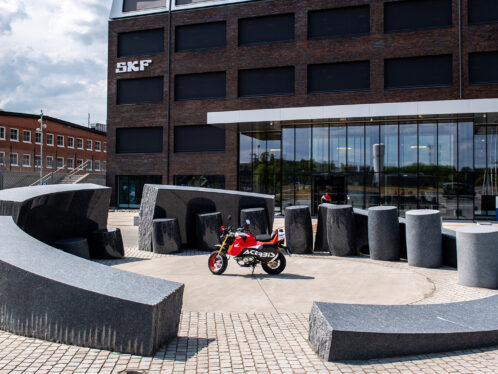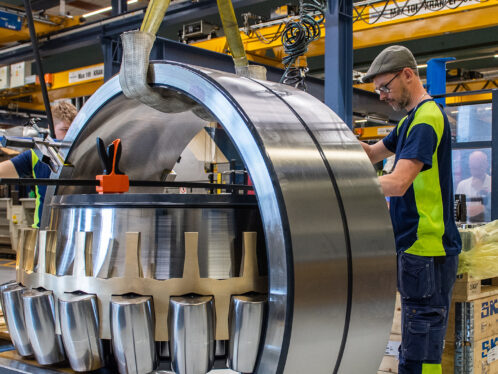
Chaya Chatterjee
When Chaya Chatterjee took over the marketing department of Škoda Deutschland five years ago at the age of 31, its products were known as cheap, cheerful and Czech. The cars’ reputation had suffered, especially in West Germany, from the long years during which Škoda had been under state control.
Chatterjee has seen it as her task to change that image, and she’s succeeding. “Many people hadn’t heard of Škoda, and among those who had, it was regarded as a cheap brand,” she says. “That was the prejudice we were confronted with, but we realised that people were surprised when they actually got into one of the cars and took a test drive, and that’s become a major part of our activities.”
As Chatterjee puts it: “If the customer won’t come to us, then we must go to the customer.” And that was the beginning of the road show. Now Škoda’s road show modules can be seen at more than 100 events a year, presenting the cars to the people. “We have a potential audience of 30 million a year,” says Chatterjee. Even if people don’t take a test ride, they are introduced to the name and learn that there’s a smart and interesting car company called Škoda.
The biggest road show is the one at the Kiel Week, a 10-day sailing regatta and fair in the northern city of Kiel that attracts a million and a half people. It’s right for Škoda because it’s a family event, and Škoda cars are being positioned as family-friendly, says Chatterjee.
When Chaya Chatterjee took over the marketing department of Škoda Deutschland five years ago at the age of 31, its products were known as cheap, cheerful and Czech. The cars’ reputation had suffered, especially in West Germany, from the long years during which Škoda had been under state control.
Chatterjee has seen it as her task to change that image, and she’s succeeding. “Many people hadn’t heard of Škoda, and among those who had, it was regarded as a cheap brand,” she says. “That was the prejudice we were confronted with, but we realised that people were surprised when they actually got into one of the cars and took a test drive, and that’s become a major part of our activities.”
As Chatterjee puts it: “If the customer won’t come to us, then we must go to the customer.” And that was the beginning of the road show. Now Škoda’s road show modules can be seen at more than 100 events a year, presenting the cars to the people. “We have a potential audience of 30 million a year,” says Chatterjee. Even if people don’t take a test ride, they are introduced to the name and learn that there’s a smart and interesting car company called Škoda.
The biggest road show is the one at the Kiel Week, a 10-day sailing regatta and fair in the northern city of Kiel that attracts a million and a half people. It’s right for Škoda because it’s a family event, and Škoda cars are being positioned as family-friendly, says Chatterjee.
Škoda ambassadors
At a Škoda road show, the emphasis is on safety – the feature most likely to appeal to families. There are road safety games for children, adults are shown how to seat children properly in the car, and the “Škoda ambassadors” emphasise the high standard of the safety features as they tell of Škoda’s other family-friendly attributes, such as ample luggage space.
Chatterjee is particularly proud of the Škoda ambassadors. As is usual at such events, many of them are local people hired for the duration of the show, but they are intensively trained to represent Škoda properly. “It makes no difference whether the person doing the promoting is a student doing it in his free time or the managing director – the consumer sees him or her as someone from Škoda, and they must fit the values represented by our brand,” she says.
Local dealers are closely integrated, too. They can give potential customers the information they need, make appointments, provide test drives and even make a sales deal. “We know that the response to the presence of the dealers is very good, and that people are encouraged into the showrooms by the road show,” Chatterjee says.
Chaya Chatterjee was born in India of German and Indian parents and grew up near Düsseldorf in the Rhineland. She says she always wanted to go into marketing and has spent the last 10 years close to Škoda, first in the agency with the Škoda account, then with the VW Bank and finally with the company itself. Since then, she and her team of 10 have had a lot to do with the brand’s success.
Škoda is the third-oldest car manufacturer still operating, and Chatterjee likes to use that as evidence for the solid quality with which she characterises the brand. “We don’t focus on it,” she says, “but it’s like an insurance policy.” And if people point to the more recent past, when Škoda’s reputation was at its lowest, she reminds them that even state central planning didn’t entirely destroy the brand.
She doesn’t want to deny the company’s history, and, symbolically, the diacritical hácek over the S has returned to the Škoda name in German.
Competitive cars
After the end of communism came the capitalist takeover of the best of the communist economy, and Škoda was no exception. In 1991, Volkswagen entered into a joint venture with what was then Czechoslovakia, which gave it 31 percent of the company, beginning a process that led to Škoda’s complete takeover. That’s meant investment, and the chance to make cars that compete at their level with anything made in the West. The emphasis is on the two newer models: the Fabia compact, introduced at the end of 1999, and the middle range Octavia, dating from 1997.
Chatterjee wants her cars to be known as products with top technology at attractive prices, and her task has been to bring that message across without spending too much money. “If I look at our competitors and see how much money is invested in straightforward advertising, I have to say we don’t have that big money,” she says. Thrift was especially necessary when she joined the company five years ago – since then, sales and advertising budgets have improved somewhat. But at the start, she had to do a lot with a little, and that meant creativity.
The road show was one result, but she also introduced a range of ideas designed to make Škoda a talking point. There were advertising campaigns emphasising road safety, like the one with the slogan “Children aren’t fitted with an airbag” that was carried out in conjunction with road safety organisations and won a government prize. That advert helped position the brand.
Škoda was also the first brand to offer a package including insurance. The idea was to surprise the public with good ideas. Chatterjee’s first slogan was “Škoda – sieh’ mal an!” (“Škoda – look at that!”)
That’s no longer appropriate, says Chatterjee. “We had to surprise in those days, but that’s not our purpose any more. Now we need to demonstrate reliability, to prove ourselves and our products.” The company seems to be on the way, with 1999 sales in Germany at 58,000, up 26 percent on the year before. But Chatterjee says she’s not finished yet. “We’re not yet where we want to be. We need to make the brand better known and to strengthen its image further.”
Chatterjee talks with enthusiasm about the vision of the first car makers, who, like Václav Klement and Václav Laurin, the founders of what became Škoda, were driven by a vision.
She uses words like dream, faith and pioneer when she talks about them. Visions are perhaps less dramatic today, but the task of recreating the Škoda brand for the German public has involved nerve, faith and plenty of pioneering spirit.
Michael Lawton
a journalist based in Köln
photo J.H.Darchinger




